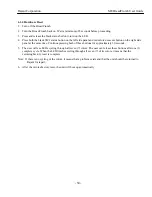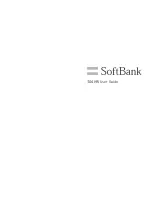
ME BreadCrumb User Guide
Rajant Corporation
- 35-
•
Devices placed too far away or in RF ‘shadows’ may experience total loss of connection.
•
Device power is important in determining distances that the device will be effective.
•
BreadCrumb ME operates at 400 mW.
•
When placing a BreadCrumb, check the connection status to the most available device with BCAdmin. If
the connection is poor or non-existent, attempt to relocate the BreadCrumb closer to the available device
until acceptable connection is achieved. If poor or no connection is made at even relatively close
distances, you should refer to the troubleshooting section of this guide.
•
When the connection quality is found to be acceptable from BCAdmin, the distance of the BreadCrumb
from the network can be increased until an optimal balance between distance, connectivity and tactical
placement is achieved.
•
BCAdmin is an administrative software application that can aid in deploying a BreadCrumb wireless
LAN. Refer to section 2 of this manual regarding BCAdmin.
4.4.3 WEATHER
Precipitation and fog also act as obstructions blocking the propagation of the wireless LAN’s radio waves.
Light fog or precipitation may result in noticeable degradation of wireless LAN performance. Heavy precipitation
or fog may result in severe performance degradation and possible loss of network connectivity.
If the performance of a well functioning LAN is degraded by increasing weather conditions, it may be
advisable to add BreadCrumb devices into the network to act as short haul repeaters to counter act the
effects of the weather. An alternative is to move the devices closer together.
4.4.4 INTERFERENCE
•
RF interference can degrade network performance and can come from many different sources.
•
Interference can come from other BreadCrumb devices that are placed too closely together.
•
Interference can come from many other RF devices such as microwave devices, cordless phone base
stations, radio transmitters, other wireless LANS, jamming devices, etc.
•
Metal surfaces such as fences and building can cause radio waves to be reflected, causing multipath
interference.
•
Plan the BreadCrumb wireless LAN to minimize the effects of RF interference.
4.4.5 PLACEMENT OF BCWL COMPONENTS
The placement of BreadCrumb devices has a major impact on maximum effective range, and therefore network
performance. The components must be elevated above the surrounding terrain to allow for adequate wave
propagation. A device placed directly on the ground has a significantly reduced effective range. Elevating a
device above the ground dramatically increased the maximum effective range. Rajant recommends elevating the
components a minimum of 6 ft. above the surrounding surface.
4.5 DEPLOYMENT CONFIGURATIONS
Sections 3.3.1 and 3.3.2 detail the two most common BCWL deployment configurations. In Section 3.3.1, the
BCWL is deployed to provide wireless network connectivity throughout a chosen coverage area. In Section 3.3.2,
the BCWL is deployed to provide wireless network connectivity reaching out into a chosen coverage area. Either
















































